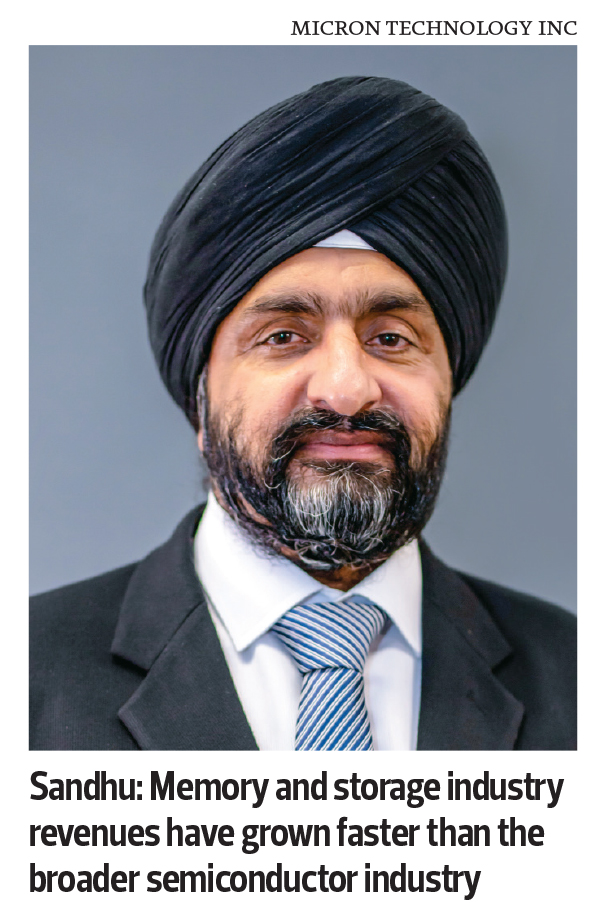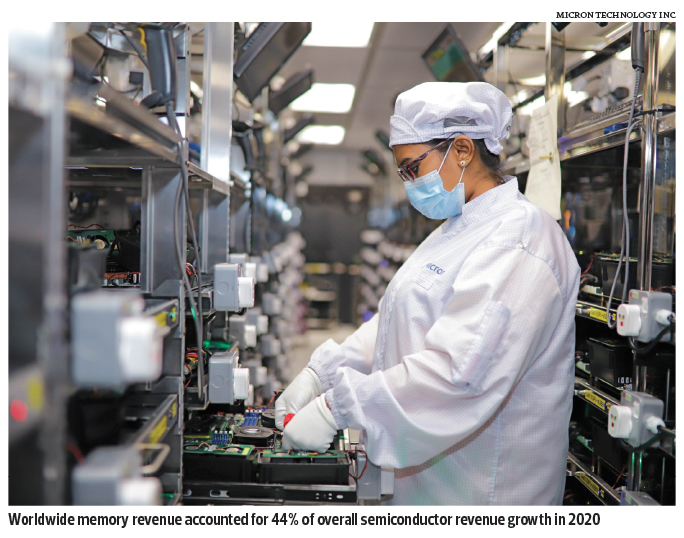
Micron has 13 manufacturing sites around the world, including its facilities in Johor and Penang. (Photo by Micron Technology Inc)
This article first appeared in The Edge Malaysia Weekly on March 15, 2021 - March 21, 2021
US-based memory chip giant Micron Technology Inc is the world’s fourth largest semiconductor vendor, with a global market share of 4.9% and revenue of US$22.1 billion (RM90.8 billion) in 2020.
The Nasdaq-listed company, which has a market capitalisation of US$95.55 billion, is closely watched by global semiconductor players as it is seen as the bellwether of the sector.
In Malaysia, Micron has two business entities, Micron Semiconductor Sdn Bhd which has operations in Muar, Johor, and Micron Memory Malaysia Sdn Bhd in Batu Kawan, Penang.
According to Micron Malaysia vice-president Amarjit Singh Sandhu, the expansion of the data economy, fuelled by the broad proliferation of artificial intelligence (AI), global deployment of fifth generation (5G) networks, as well as the expansion of the intelligent edge, is anticipated to deliver more opportunities for memory and storage as data moves to the centre of all computing experiences.
“At Micron, we invest in manufacturing and operational excellence to fuel product delivery today and innovation tomorrow. This starts with deep investment in manufacturing innovation to meet rising memory and storage demands and focus on operational excellence to navigate the volatility of the marketplace,” he tells The Edge in an email interview.
Sandhu says Micron is on the right track in expanding its manufacturing presence in Malaysia to support the increased sales of 5G phones, continued sales of new gaming consoles and graphics cards, as well as healthy growth in cloud and personal computers (PCs).
“Globally, Micron has 13 manufacturing sites at the moment, including our facilities in Johor and Penang. Our site in Batu Kawan will become Micron’s Centre of Excellence (CoE) for solid state drive (SSD) assembly and test. This new location will enable the company to optimise our global footprint and better serve customers, while ensuring we attract and retain the highest-quality talent,” he remarks.
SSD is a type of mass storage device similar to a hard disk drive. It supports reading and writing data and maintains stored data in a permanent state even without power.
Sandhu has over 28 years’ experience in the semiconductor assembly and test industry. Prior to joining Micron, he was senior director of assembly and test operations at Western Digital.
Founded in 1978, Micron is a global leader in memory and storage solutions. Sandhu highlights that the company, backed by over 40 years of technology leadership and over 44,000 lifetime patents granted, is focused on delivering solutions to solve the world’s most significant computing challenges.
“Semiconductor manufacturing is among the most complex processing technologies in the world. From the raw material sand, we take it through a complex process, then turn it into the semiconductors that power the electronics that are in smartphones, laptops, PCs, servers and data centres,” he explains.
Sandhu, who is currently responsible for directing Micron Malaysia’s back-end manufacturing teams in Johor and Penang, says the group has over 2,000 team members in both sites, created to run in parallel in terms of operations and to strengthen the local electrical and electronics industry.
Micron’s presence was first established in Johor in 2010. Its current facility in Muar serves as an assembly, test and finishing site for Micron’s NAND/multichip packages for the mobile market, and NOR flash memory products.
“Our site in Muar strives to deliver cost-effective and high-quality memory solutions, and partners with Micron Singapore sites as the NAND CoE,” says Sandhu.
NAND is a type of non-volatile flash memory, meaning it does not require power to retain or store data. Devices such as digital cameras, USB flash drives, smartphones and SSDs utilise NAND flash memory for storage.
Meanwhile, NOR flash memory is another type of non-volatile storage technology, which is faster to read than NAND flash, but more expensive, and also takes longer to erase and to write new data. NAND has a higher memory capacity than NOR.
In November 2018, Micron announced a RM1.5 billion greenfield investment plan for its new CoE for SSD assembly and test in Batu Kawan Industrial Park. Construction plans are expected to be completed by early this year.
After a preliminary screening of locations in Malaysia, Sandhu says Micron selected Penang because of its good supply chain ecosystem for the electronics industries, logistics, sustainable manufacturing infrastructure, favourable business environment, proximity to centres of excellence for semiconductor and storage products, and availability of high-quality talent.
“The new facility in Batu Kawan will enable us to achieve manufacturing excellence by executing our technology road map while maintaining the required scale, cost, quality and speed throughout the operations cycle. Under the same roof, we could facilitate collaborations between technology development and manufacturing through vertical integration,” he elaborates.
A check on the Companies Commission of Malaysia website shows that Micron Memory Malaysia, which was incorporated in October 2018, registered a loss after tax of RM9.26 million in the financial year ended Aug 29, 2019 (FY2019), on revenues of RM25.73 million.
As for the Johor operation, Micron Semiconductor posted a 33.3% increase in net profit to RM23.66 million in FY2019, from RM17.74 million in the previous year. The company’s revenue also increased by 11.8% to RM518.229 million in FY2019.
Commenting on the business opportunities and market challenges for Micron in the coming years, Sandhu says he is excited about the growth and health of the group’s diverse end-markets, which continue to benefit from powerful secular technology trends, including AI, cloud and the intelligent edge.
“These trends are already enabling the data economy and increasing the importance of DRAM (dynamic random-access memory) and NAND. Memory and storage industry revenues have grown faster than the broader semiconductor industry, from approximately 10% of semiconductor industry revenues in the early 2000s, to now approaching 30%,” he says.
DRAM is widely used in digital electronics where low-cost and high-capacity memory is required, such as computers and graphic cards.
According to preliminary reports by Gartner, worldwide semiconductor revenue rebounded in 2020 to US$449.8 billion, an increase of 7.3% from 2019. Memory, the best-performing device category in 2020, benefited from the increased server build, PC and ultramobile demand arising from the shift to home working and learning. Worldwide memory revenue increased US$13.5 billion in 2020, accounting for 44% of overall semiconductor revenue growth in 2020.
Sandhu opines that this is an opportunity for Micron to unleash its leading technical minds to drive innovation in memory and storage.
“We are forecasting our customers’ needs today and tomorrow through delivery of the industry’s broadest, most innovative portfolio of memory, storage and accelerator solutions for data centre, intelligent edge and devices, and a pipeline of innovative technologies that will deliver a renaissance of infrastructure innovation,” he says.
Save by subscribing to us for your print and/or digital copy.
P/S: The Edge is also available on Apple's App Store and Android's Google Play.
- Xi's showdown with Li Ka-shing threatens China’s pro-business push
- Tan Kean Soon steps down as T7 Global executive deputy chairman, board says no operational impact
- Company auditor loses RM1.29m to investment scam
- Perak emerges as Malaysia's No 1 sweet corn producer
- Huawei posts surprise loss after aggressive tech research


